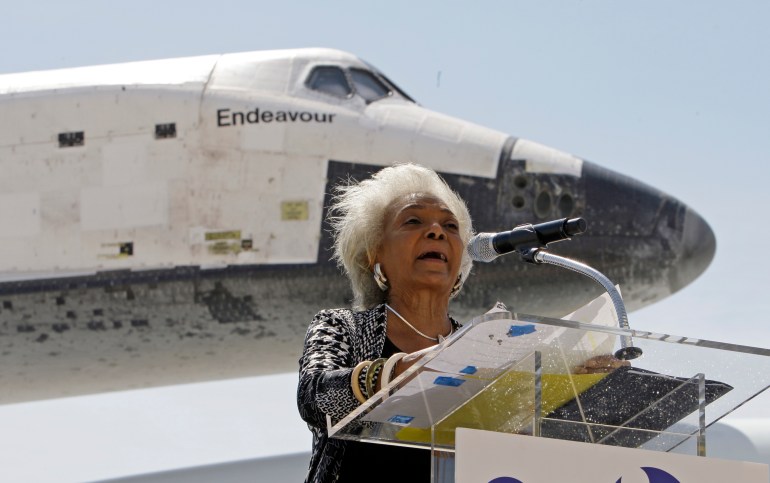In February, NASA made history with the successful landing of a car-sized robotic explorer on Mars, and its counterpart: a small helicopter that more recently proved powered flight is possible even in the thin atmosphere of Mars.
Together this dynamic duo will unlock even more of the Red Planet’s secrets. The Ingenuity helicopter, a technology demonstration, is set to make a second, more complex flight next week.
Meanwhile, the Perseverance rover showed that it definitely has MOXIE in more ways than one — its Mars Oxygen In-Situ Resource Utilization Experiment (MOXIE for short) extracted carbon dioxide from the Martian atmosphere and converted it into oxygen.
This has huge implications for future astronaut missions to the moon and Mars, which will require oxygen as fuel components and for crews to breathe.
Amazing science and technology demonstrations aside, the Perseverance mission is making history in another way: by exemplifying diversity within NASA, the United States space agency.
Rover representation
The face of the mission is Swati Mohan, an Indian-American aerospace engineer who first delivered the news that the Perseverance rover had successfully landed on Mars on February 18.
“Touchdown confirmed,” she announced to roaring applause from mission control at NASA’s Jet Propulsion Laboratory in Pasadena, California. “Perseverance safely on the surface of Mars, ready to begin seeking the signs of past life.”
Throughout the landing sequence, Mohan was at the forefront of the control room, providing constant updates to the team and serving as the mission’s commentator.
Before she was the face of the mission, Mohan worked for years to make it all happen as part of the entry, descent and landing team.
Not only is she the guidance and controls lead for the rover mission, she is a reflection of the progress NASA has made to become more diverse. Mohan is an Indian-American who moved to the US from India as a child, and grew up dreaming about space.
Star Trek opened up her world to the beauty of the universe. But it wasn’t until she took her first physics class that she decided she wanted to be an engineer. That decision led to her helping NASA to explore different regions of the solar system.
“I remember thinking ‘I want to do that. I want to be the one to find new and beautiful places in the universe,’” she told Al Jazeera during the Mars Perseverance launch last summer. “The vastness of space holds so much knowledge and we have only begun to scratch the surface.”
While Mohan may have helped steer the rover in the right direction on its journey to Mars, she and her teammates are also an example of how NASA’s decades-long push to become more diverse is paying off.
To boldly go
That push started back in the 1970s thanks, in part, to Star Trek. Nichelle Nichols, who played Lieutenant Nyota Uhura on the popular television show, helmed a campaign to help NASA recruit a new crew of astronauts who would fly its burgeoning space shuttle programme.
Nichols travelled the country in hopes of diversifying NASA’s astronaut corps. When the agency opened, its corps of space flyers was limited to one group of people: military pilots. But with a fleet of space shuttles ready to take off, NASA would need many more astronauts.
She helped to recruit a more diverse set of people, including many women and minorities such as Sally Ride, Judith Resnik, Guion Bluford, Ronald McNair and Mae Jemison and Ellison Onizuka.
Nichols also targeted those that the military might have overlooked in their astronaut recommendations, like three-time shuttle astronaut Fred Gregory, who served as a colonel in the US Air Force.
 Nichelle Nichols, the actress who portrayed Lieutenant Uhura on the 1960s television series Star Trek, helped NASA recruit a new generation of astronauts in the 1970s [File: Reed Saxon/AP Photo]
Nichelle Nichols, the actress who portrayed Lieutenant Uhura on the 1960s television series Star Trek, helped NASA recruit a new generation of astronauts in the 1970s [File: Reed Saxon/AP Photo]It was during this time that the people NASA sent into space began to come from more diverse backgrounds and were able to bring new skill sets to the table. The majority of recruits were still white men, but this was a turning point for the agency as people around the country could actually see themselves represented in missions.
The space shuttle has since retired, but NASA’s push to be more inclusive has only gained momentum, as evidenced by the agency’s more recent astronaut selections.
In 2013, for the first time in history, half of the class were women. The next group selected was even more diverse as it also included a mix of ethnicities.
NASA also strives to not only put a woman on the first lunar mission, but also a person of colour. That mission is part of NASA’s Artemis lunar programme, and will mark the first time in history that either has gone farther than the International Space Station.
These types of drives would not be possible if it weren’t for missions like the Perseverance rover, where the world can see a vast array of people needed to make a mission possible.
Mohan may be the voice that kept us all informed, but the crew behind the historic spacecraft is led by diverse team members including landing lead Allen Chen and engineers Moogega Cooper, Cj Giovingo and Gregorio Villar, who are breaking barriers as leads in their field from different ethnicities and the LGBTQ community. Their presence shows that NASA is continuing to make progress on the diversity front.
Space is for everyone
NASA is also helping to inspire other agencies to push for more diverse teams and help provide opportunities for more people to travel to space. With the advent of its commercial crew programme, NASA and its partners are ensuring that more astronaut missions can get off the ground, which allows for more astronauts to be recruited.
“With all of the different players involved and the burgeoning commercial industry, there’s a drive to be more diverse,” NASA astronaut Jessica Meir told Al Jazeera. “That’s how we move forward in spaceflight.”
Meir was one of two astronauts whose incoming class in 2013 was the first to be a 50/50 split between males and females. She also took place in the first all-female spacewalk in 2020, along with fellow astronaut Christina Koch.
“I think that giving more humans access to space is going to propel us in the right direction,” she said.
NASA selects astronauts every few years, while other agencies, like the European Space Agency (ESA), recruit only about once a decade.
 NASA astronaut Jessica Meir spent more than 200 days in space before landing back on Earth on April 17, 2020 near the town of Dzhezkazgan, Kazakhstan [File: Roscosmos Space Agency via AP]
NASA astronaut Jessica Meir spent more than 200 days in space before landing back on Earth on April 17, 2020 near the town of Dzhezkazgan, Kazakhstan [File: Roscosmos Space Agency via AP]With SpaceX flying regular crew missions to the space station, ESA recently announced that it needs more astronauts. In particular, the agency is looking to see if it can hire the first disabled professional astronaut.
“We are launching a new astronaut selection campaign,” ESA’s Frank de Winne told Al Jazeera. “We need to have a more diverse astronaut corps.”
He said that the agency is doing a feasibility study to see if it’s possible to include persons with disabilities in its astronaut selection process. Among the key issues ESA is examining is the ability to get in and out of the capsule quickly in the event of an emergency. But the agency is serious about being able to include more people in its selections.
“We want that person to be a professional astronaut, not just a one-and-done flyer,” de Winne said. “We want to take that step and need to examine it from a crew safety standpoint.”
For its part, NASA’s office of diversity and inclusion said that its progress is the result of its outreach initiatives.
Among them have been yearly college engineering competitions that focused on minority-serving institutions, said Kim Orr of NASA’s outreach office for STEM (science, technology, engineering, and mathematics).
“As an agency, NASA would target those communities so that the students would have access to NASA employees and have a valuable resource to further their careers,” Orr told Al Jazeera.
In recent years, however, NASA’s education budget took a hit. But the agency is hopeful that the administration of new US President Joe Biden will help bolster some of those efforts so that the agency can continue to recruit the best and the brightest to continue to “dare mighty things”.
There is still a lot of progress to be made, but NASA’s workforce now looks much more like the nation it represents.




